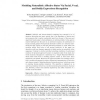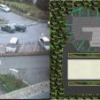91 search results - page 13 / 19 » Modelling user attention for human-agent interaction |
AIHC
2007
Springer
14 years 1 months ago
2007
Springer
Affective and human-centered computing have attracted a lot of attention during the past years, mainly due to the abundance of devices and environments able to exploit multimodal i...
CVPR
2007
IEEE
14 years 9 months ago
2007
IEEE
Learning from experience is a basic task of human brain that is not yet fulfilled satisfactorily by computers. Therefore, in recent years to cope with this issue, bio-inspired app...
CONTEXT
2007
Springer
14 years 1 months ago
2007
Springer
Abstract. This paper presents a statistical framework based on Principal Component Analysis (PCA) for discovering the contextual factors which most strongly influence user behavio...
HRI
2007
ACM
13 years 11 months ago
2007
ACM
In many settings, such as home care or mobile environments, demands on users' attention, or users' anticipated level of formal training, or other on-site conditions will...
CHI
2008
ACM
14 years 7 months ago
2008
ACM
Non-verbal behavior, particularly gaze, is a crucial part of human communication. To interact with humans in a rich, natural way, social interfaces need to use this communicative ...


